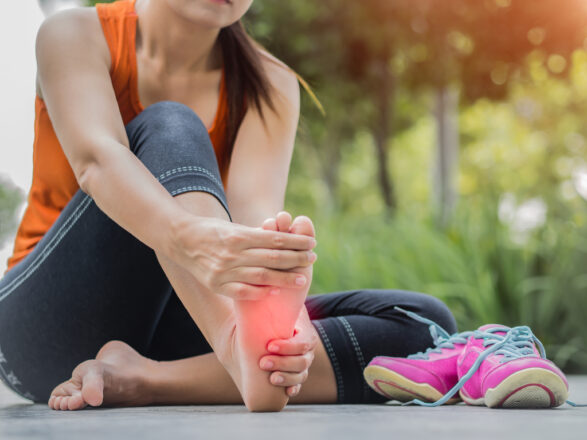Ankles rolling inward as you run? You may be overpronating. Like underpronation, overpronation increases your risk of uncomfortable injuries that can sideline you.
Knowing whether you overpronate or underpronate can help you correct your pronation and run better.
Read on as we explain overpronation vs. underpronation. We’ll also be talking about causes and how to correct overpronation or underpronation.
In This Article
In This Article:
What Is Overpronation?
When you overpronate, your foot rolls downward and inward too much as you walk or run. Because of this, you push off the ground with your big toe, and so your feet twist more than normal.
Pronation refers to how your feet function when they contact the ground as you take a step. When your foot touches the ground, the arch of your foot flattens to absorb the shock of impact. Ideally, your foot should roll forward from heel to toe, which is known as neutral pronation.
Normal pronation is when your foot rolls inward at the ankle by around 15%. This distributes the shock of the impact.
Good to know: When you overpronate, your running shoes will show more wear around the inner side of the heel and forefoot.
Overpronation causes more than the uneven wear of your running shoes. It reduces the stability of your foot, strains your big toe, and rotates the tibia more. Excessive pronation is often to blame for heel pain, according to the American Podiatric Medical Association (APMA).
It can also cause heel pain, plantar fasciitis, shin splints, bunions, low back pain, and even stress fractures in the foot or lower leg.
What Is Underpronation or Supination?
Underpronation, also known as excessive supination of the foot, occurs when your weight rolls to the outer edges of your feet as you take a step.
This places more stress on the smaller toes and outer edges of the foot, which have to work harder when the toes leave off the ground.
Good to know: When you underpronate, your running shoes will show more wear on the outside edge.
Underpronation is less common than overpronation. But if it’s left unchecked, it can lead to ankle injuries, plantar fasciitis, hip and back pain, and Achilles tendonitis.
A 2018 case-control study found that high supination significantly increases the risk of foot injuries in novice runners, as does high pronation, compared to a neutral foot posture.
Other major factors that increase the risk of running injuries include hard running surfaces, a high body mass index, using only one pair of running shoes, and lack of running experience.
What Causes Overpronation and Underpronation?
Overpronation and underpronation can each have multiple causes. Let’s take a closer look at the causes behind the most common foot pronation problems.
Overpronation causes
People with flat feet often overpronate. But not all flat-footed people are overpronators.
Pronating too much as you run can also lead to flat feet, which in turn can worsen overpronation and increase the risk of running injuries.
Being overweight or pregnant can make your feet overpronate to balance the weight you are carrying.
Underpronation causes
Having high arches that don’t flatten enough as you walk often causes underpronation.
Muscle imbalances in the lower leg can also lead to underpronation, as can past foot injuries or wearing the wrong running shoes.
Running or walking too much or standing on hard surfaces for long periods can also lead to gait imbalances, as can having one leg slightly shorter than the other.
The bottom line is that overpronation and underpronation aren’t only a question of the feet you are born with but how much you train, your running style, and the surfaces you run on.
Signs You Suffer From Underpronation
The signs that you are underpronating can be subtle at first. Spotting them early on can help you correct underpronation before it can contribute to more serious running injuries like plantar fasciitis or stress fractures.
- Your running shoes wear out unevenly. A simple way to see if you underpronate is to take a good look at your running shoes. Place them on a flat surface and see if they tilt outward. If they do, you are underpronating.
- You develop shin splints. When you underpronate, your foot doesn’t absorb shock as effectively as a foot in a natural posture. Over time, this can lead to lower leg pain below the knee.
- You suffer from plantar fasciitis pain. Another common injury caused by underpronation is plantar fasciitis. This occurs when the strain on the plantar fascia, the ligament connecting the toes with the heel, leads to aching or stabbing pain in the heel or along the arch of the foot.
- You have a sprained ankle. Underpronating puts more pressure on the outer part of your feet. This reduces the stability of your ankle and increases the risk of ankle sprains.
- You develop a stress fracture in your foot. The additional pressure that your metatarsal bones in the middle of your foot have to withstand can lead to stress fractures. Less commonly, the fibula may also suffer a fracture.
How to Treat Underpronation/Overpronation or Imbalanced Gait
The best treatment for underpronation or overpronation is adapted to the severity of your condition. If you don’t have any symptoms, begin with the shoe tilt test:
1. Place a pair of well-worn sneakers on a table with the heels facing you.
2. Look carefully at the heels.
a. If the heels tilt outward, you may be underpronating.
b. If the heels tilt inward, you are overpronating.
For more accurate results, have your gait pattern checked as you walk. Gait analysis is available in larger running shoe stores.
If you experience symptoms, it’s best to see a podiatrist (a specialized foot and ankle doctor). Podiatrists can both diagnose and prescribe optimal treatment.
Treatments for overpronation
- Stability running shoes with midsole support.
- Motion control shoes that limit excessive pronation.
- Custom orthotics that support your feet. A 2018 study backs the use of arch-support foot orthoses to normalize foot pressure due to pronation when running. By doing so, it can help treat and prevent medial tibial stress syndrome that affects many recreational runners.
Treatments for underpronation
- Shoes with a flexible sole or that provide cushioning that absorbs the impact of the foot strike.
- Custom orthotics designed for underpronating feet. Some research suggests that custom-made insoles may help reduce shin splints.
When running, proper running form can help with both overpronation and underpronation. Keep the following tips in mind:
- Land softly on the ground
- Don’t pound the ground as you run
- Touch the ground with your midfoot rather than your heel
- Shorter your stride
- Increase your cadence
Exercises for Overpronation and Supination
A 2020 study investigated the effects of a 9-week strength training program on pronation. The program trained foot muscles and core muscles in 2 40-minute weekly sessions.
The study found that participants who underwent the training had better foot posture.
Research shows that performing exercises that stretch the leg muscles can improve your ankle’s range of motion. This, in turn, may help reduce running injuries, including those associated with overpronation and supination.
Overpronation and underpronation exercises don’t take long, and you can do them at home.
Overpronation exercises
Perform the following exercises seated on a chair. To see improvements, do them regularly.
- Big toe stretch. Place your ankle on the opposite knee. Hold your big toe with one hand and pull it back slowly, maintaining the tension for 15 seconds. Then repeat with the other foot.
- Towel curls. Place a small towel under your foot. Pull the towel toward you with your toes, arching your foot but careful not to move your heel. Do this for one minute and then switch legs.
- Foot rolling with a tennis ball. Place the ball under your foot and lean forward, putting weight on your foot. Roll the ball under your foot, starting from the big toe and moving toward the heel with a slow and controlled movement. Increase the pressure by pointing and flexing your toes.
- Short foot. Place your foot on the ground and pull your toes down and in without them leaving the ground. Lift the arch of your foot off the ground and contract your arch muscles for 3 seconds before releasing the tension to complete a repetition. Do 2 sets of 10 reps each.
Underpronation exercises
Underpronation exercises include ankle pronation and other exercises you perform standing or seated. By stretching your leg muscles, these exercises can improve your ankle’s range of motion. For some of these exercises, you will need a resistance band or a foam roller.
- Ankle flexion. Raise your foot off the ground and flex your ankle with a slow and controlled movement. Then make small circles with your foot. Set aside a few minutes for this exercise.
- Single-leg calf raises. Holding on a chair for support, lift one foot off the ground, balancing on one leg. Slowly raise the heel of the support leg until you stand on your toes and your heel is high while keeping the other leg lifted behind you. Bring the foot of your support leg back to the floor to complete a rep. Do 2 sets of 12 reps each.
- Calf rolls. Sit on the floor with arms behind you and legs extended in front of you. Place the foam roller under your calf and roll back and forth for 60 seconds. Then switch legs.
- Resistance band foot pulls. Sitting on the floor, place a resistance band around the ball of your foot and gently pull it back with your hands. Do this for a few minutes, then switch feet.
Best Shoes for Overpronation and Underpronation
The best shoes for overpronation help stabilize your feet. Motion control shoes are stiffer than regular running shoes and provide medial support that can reduce excessive pronation.
If you overpronate, wearing running shoes with motion control when heading out for a run can help reduce injury risk, according to science.
The best shoes for supination or underpronation are flexible and lightweight. Underpronation shoes provide good cushioning that can ease some of the stress on your foot and leg bones.
To choose the best running shoes for underpronation or overpronation, have your gait analyzed first. Also, running shoes wear out fast, so grab two pairs.
Takeaways
Now that we’ve reached the end, here are the key things to remember:
- Foot pronation that is excessive or insufficient can cause running injuries over time.
- Leaving pronation problems uncorrected can cause serious injuries.
- You can correct overpronation or underpronation by using the right shoes and custom orthotics.
- The best shoes for underpronation are lightweight and flexible, while the best shoes for overpronation are stiffer and provide more foot support.
- Home exercises like towel curls or ankle flexion can also help.














